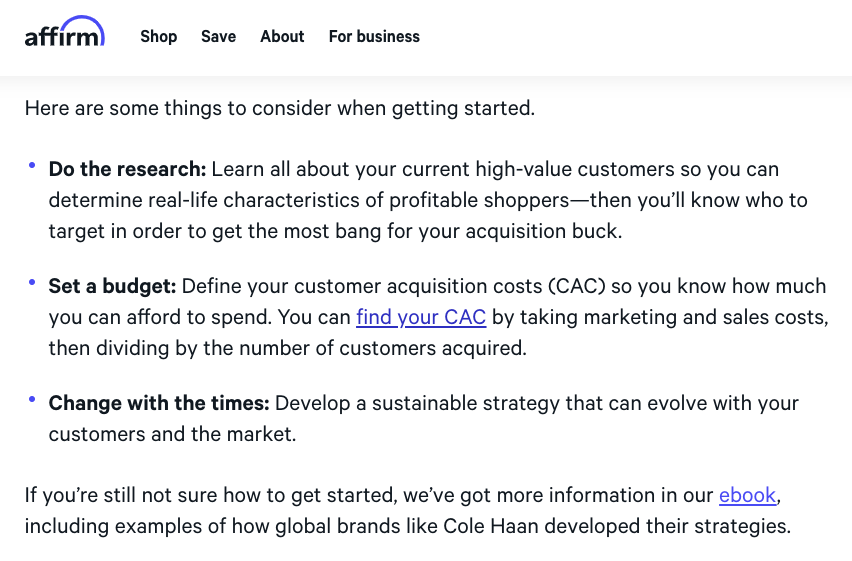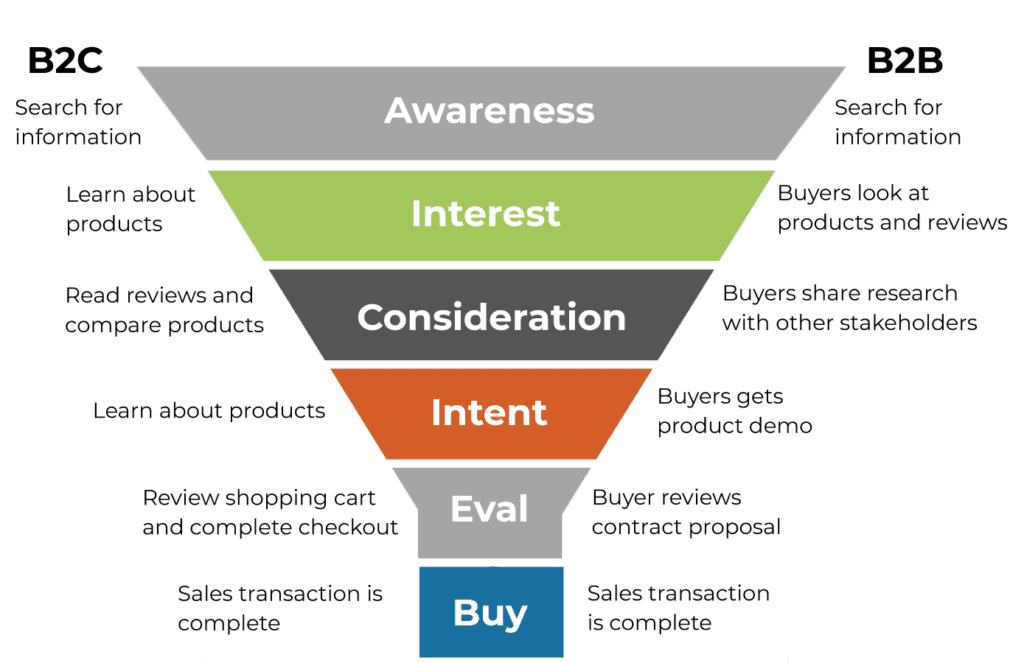The practice and industry of Search Engine Optimization (SEO) has been around for quite a while now. People generally tend to think about an SEO strategy in terms of ranking high in popular keyword searches. But for business-to-business (B2B) companies, the strategy shifts from a broad audience to a very specific one.
B2B SEO has a few basic areas that differ from B2C SEO. In this guide, we’ll outline those key differences and how you can better your own B2B SEO strategy.
What is B2B SEO?
B2B SEO is the online practice of using various techniques – like keyword research and a page’s metadata – to reach the decision-makers of a company. A successful strategy means that someone actively researching the product or service that you’re offering reaches your company’s website.
There are a few different elements to B2B SEO. Each one plays a role in your overall strategy. If you’re lacking in one area, it means you’ve still got room to optimize your site.
- Technical SEO: These are the optimizations you make to the backbone of your website. It covers areas like your XML sitemap, load speed and a responsive design.
- Content SEO: B2B content marketing for SEO is the practice of using research on user needs and search intent to create content. You go through the steps of research, ideation, content creation and promotion.
- On-page SEO: This is the optimization of the content itself. On a page or blog post, it includes the meta description and title tag, alt text on images and structuring the content so information is relevant to both the user and findable by search engines.
- Off-page SEO: Also referred to as backlinks, having high-quality pages link to you on a specific topic increases your perceived expertise in said topic. It also includes engagement on the page or post. The links in the below blog post from Affirm show off an example of using off-page SEO.

In a blog post about small business customer acquisition, Affirm links the phrase “find your CAC” to a HubSpot article on what a CAC is. For HubSpot, this is considered a backlink (or a win for off-page SEO) and a good one since it’s both a reputable website and a relevant keyword phrase.
These four SEO types combine to create your SEO strategy at a high level. Now we’ll go into more detail on how to apply these functions to a B2B marketing strategy.
What is the difference between B2B & B2C SEO?
Conceptually, B2B and B2C SEO have a similar basic goal: you want people searching for you to find you. But in practice, it’s a lot more complex and the strategic approach is different. Here are four key differences between B2B and B2C SEO.
1. More time in each sales stage

The B2B sales funnel has the same stages as a B2C funnel but the time spent in each one is much longer. In B2B, a decision-maker spends a lot of time in the research stage, collecting information about various offerings. There’s often a significant back-and-forth between the seller and the potential client where the prospective customer will read up on case studies, watch product demos and negotiate a contract. Because of this long period of time and the different needs of each step, a lot of different content is produced for each stage to entice the potential buyer.
2. Don’t ignore low-volume and long-tail keywords
Another difference in B2B SEO ideation is how you approach keywords. In B2C, you want a lot of people to search for your product type and then buy yours. Ranking high in common keyword searches is important. In B2B SEO, it’s often important to also target low-volume keywords. These are specific and entice only a small number of searchers. But these people are the ones who are most interested in the content you present. These highly specific phrases are often called long-tail keywords.

In the above example, someone might be researching the benefits of using a customer service chatbot. The article from Intercom is an introduction to chatbots and how they can improve customer service. It’s the perfect article to show up for this search result. Motivated buyers are much more likely to search highly specific queries like this, compared to a broad but higher volume one like “what is a chatbot,” which might only be a general information search.
3. Low conversion rate
Going hand in hand with the long time in each sales stage is the conversion rate. Because so much time is spent gathering info, it means that a lot of content is also being consumed. But all that content isn’t going to immediately lead to a purchase. It’s rare for a business decision-maker to browse a page and then decide that’s the product they’re going with. This leads in to the need to approach content planning strategically for B2B SEO.
4. Content for decision-makers

When you write your blog posts or landing pages, you aren’t usually writing in a casual, playful, eye-catching manner like you would for B2C content. B2B content tends to veer into the more informative, professional and data-driven territory. Many different types of content are utilized with each one aimed for a different B2B sales stage. Oftentimes, the content is also specific. For example, someone searching for a PR agency won’t just search “PR agency.” They’re going to look for one in their industry or market such as “Houston restaurant PR agency.” Having content for each industry you serve makes each piece far more valuable.
Tips for creating an effective B2B SEO strategy
Now that you know the differences between B2C and B2B approaches to SEO, it’s time to set up or examine your strategy. Having every element of your SEO approach working together is most effective, compared to devoting all your resources to one aspect. Having content show up in a relevant search won’t do you any good if that page isn’t loading quickly. And targeting high-volume keywords at random won’t help you reach the right people without greater audience insight.
Create buyer personas
A key part of conducting B2B market research for your company includes creating buyer personas. Just like a customer persona, a buyer persona details who they are, which industry they’re in, what their position is, who they consult for making a decision and more. The more details you have about the buyer persona, the better you will be in crafting content.

Before you create a buyer persona, make a list of questions you need to know about each buyer. Make it a template so you can easily fill it in for each persona. In the above example, you can see how one company crafted a persona that includes education, responsibilities and sources they trust.
Keyword research allows you to know how many people are searching for each given phrase. But more importantly, it helps guide your buyer persona, build your content strategy, conduct a competitor analysis and more. Keyword research is not limited to search engines. It includes social listening, where you can see what people are discussing online and evaluating your brand sentiment. In the above example, someone searching for commercial juice press machines would end up on this page. Mid-page, the company inserted a free eBook on a very relevant topic for their target audience. The ebook demonstrates the company’s knowledge about the subject and hopefully reinforces that idea in the buyer’s mind. Work on that technical and on-page SEO. Depending on how your website is designed, it might already have built-in SEO enhancements or you might need assistance from developers to improve it. Sites built with WordPress have a wide array of SEO plug-ins to choose from. Sites built with out-of-the-box templates may be harder to edit the specifics you need to optimize your content. Website and on-page optimization includes but is not limited to the below: There’s so much content to choose from, what do you focus on? Start small by creating one piece of content for each sales stage. Enhance each one with SEO strategies and create for the buyer persona that you’re targeting. The above table shows examples of where each type of content can be used for each sales stage. As you create more content in each area, note down the data associated with each one. Are webinars gaining more attention than expected? Create even more in targeted topic areas. If you already have content on your site, take a look at the older blog posts. If they’re still relevant, try updating them with fresh information or create a different content type on the same subject. A how-to video could easily be turned into an article with photos. As mentioned earlier, being specific in your content is helpful for B2B SEO. Having a landing page tailored for each buyer persona or business type that you aim for makes that page more valuable than a generic one. In Sprout’s menu, you can see how business types and industries are divided up. The Travel and Hospitality link leads to a page that includes current travel customers, how a company would deliver customer care and testimonials from related brands. The copy is written specifically for someone who works in the travel industry and whose company serves travel customers. Having great backlinks can only make your website seem more authoritative. Off-page SEO includes both website backlinks and social media posts. But this portion of B2B SEO is more difficult because it’s less within your control. Cold emailing a company and asking them to link to your blog post could be considered poor form and isn’t likely to be a good use of your SEO team’s time. Instead, there are some other options you can consider. Craft a B2B social strategy that includes the promotion of your current content. How will businesses know about that great white paper you spent days working on if you don’t promote it everywhere? Don’t wait for a business to land on your site to finally share that piece of content. Similar to your approach to social media content, creating high-quality and informative content that is inherently share-worthy can help it gain links organically as audiences find it useful. Also, using other resources like a PR agency or influencers can increase your chances of getting backlinks. Product reviews, social media recommendations and CEO interviews in articles are all ways to work on your off-page SEO. B2B and B2C SEO may have a similar marketing funnel, but the time spent in each stage and the content supporting the strategy differs. While much of B2C SEO is focused on getting a lot of people who are searching for a popular keyword to find your company’s website, B2B aims for lower volume results. The content is specific and informational, written with the company’s buyer persona in mind. Your B2B SEO strategy will not be the type that you set it and be done with it. You’ll need to consistently optimize and update existing pages, develop new content update new pages with SEO, create new blog posts for different keywords and edit your buyer personas as time passes. To get started, check out our guide to developing B2B social media posts to start getting inspired on your content. The post The complete guide to B2B SEO appeared first on Sprout Social.

Optimize your website & pages

Create relevant content for each sales stage


Promote the content
.Get started on your B2B SEO strategy